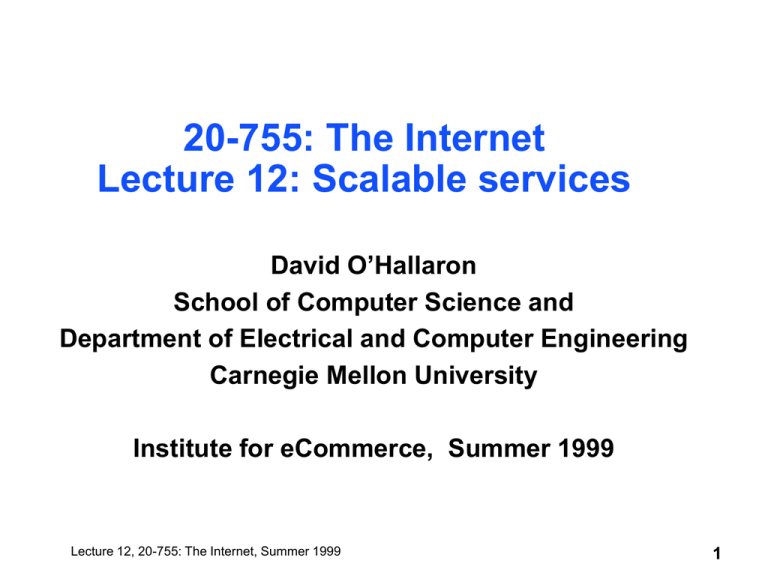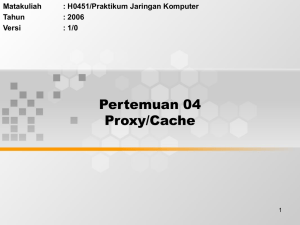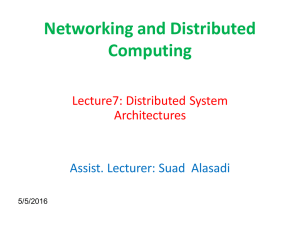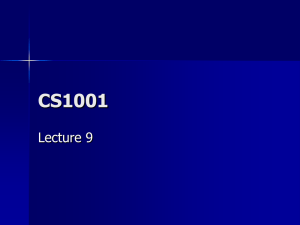20-755: The Internet Lecture 12: Scalable services
advertisement

20-755: The Internet
Lecture 12: Scalable services
David O’Hallaron
School of Computer Science and
Department of Electrical and Computer Engineering
Carnegie Mellon University
Institute for eCommerce, Summer 1999
Lecture 12, 20-755: The Internet, Summer 1999
1
Today’s lecture
•
•
•
Speeding up servers (30 min)
Break (10 min)
Caching (50 min)
Lecture 12, 20-755: The Internet, Summer 1999
2
Scalable servers
•
•
Question: How do we provide services that
scale well with the number of requests?
Goals for high-volume sites:
– Minimize request latency (response time) for our clients.
» want to avoid the dreaded hourglass
– Minimize the amount of traffic over our high-speed
Internet connection.
» Many ISPs charge monthly rates based on actual
bandwidth usage.
» Recall MCI T1 and T3 pricing from Lecture 6
(programming the Internet).
Lecture 12, 20-755: The Internet, Summer 1999
3
Scalability approaches
•
Speed up the servers
– Use multiple processes to handle requests
» concurrent servers
» pre-forking servers (not covered here)
– Use multiple computers to process requests.
» clustering (not covered here)
– e.g., Microsoft cluster, HotBot cluster
» distributed servers (not covered here)
– use DNS to send requests to geographically
distributed mirror sites.
•
Move the content closer to the clients.
– Caching
– Crucial concept (and big business)
Lecture 12, 20-755: The Internet, Summer 1999
4
Iterative servers
•
An iterative server processes one connection
at a time.
# simple iterative server
while (1) {
connfd = accept();
<process request using socket connfd>
}
Lecture 12, 20-755: The Internet, Summer 1999
5
Iterative servers
•
Step 1: server accepts connect request from
client A.
client
B
client
A
connection
request
Lecture 12, 20-755: The Internet, Summer 1999
server
listen socket
6
Iterative servers
•
•
Step 2: Server processes request from client
A (using A’s connection socket)
Client B initiates connection request and
waits for server to accept it.
client
B
client
A
connection
request
listen socket
server
process
request
Lecture 12, 20-755: The Internet, Summer 1999
client A’s
connection socket
7
Iterative servers
•
•
Step 3: Server finishes processing request
from Client A.
Accepts connection request from Client B.
client
B
connection
request
client
A
Lecture 12, 20-755: The Internet, Summer 1999
server
listen socket
8
Iterative servers
•
Step 4: Server processes request from client
B (using B’s connection socket)
client
B
process
request
client
A
Lecture 12, 20-755: The Internet, Summer 1999
listen socket
server
client B’s
connection socket
9
Iterative servers
•
•
Step 5: Server finishes process client B’s
request.
Server waits for connection request from next
client.
client
B
client
A
Lecture 12, 20-755: The Internet, Summer 1999
server
listen socket
10
Iterative servers
•
Pros
– Simple
– Minimizes latency of short requests.
•
Cons
– Higher latencies and lower throughput (requests/sec) for
large requests
» large response bodies that must be served off disk
» long running CGI scripts that access disk files or
databases.
» no other requests can be served while other work is
being done.
Lecture 12, 20-755: The Internet, Summer 1999
11
Concurrent servers
•
A concurrent server accepts connections
from a parent process and creates children to
process the requests.
# concurrent server
while (1) {
connfd = accept();
pid = fork();
if (pid == 0) { # child process
<process request in child process>
exit();
}
}
Lecture 12, 20-755: The Internet, Summer 1999
12
Concurrent servers
•
Step 1: server accepts connect request from
client A.
client
B
client
A
connection
request
Lecture 12, 20-755: The Internet, Summer 1999
server
listen socket
13
Concurrent servers
•
•
Step 2: Server creates child process to handle
request.
Client B initiates connection request and
waits for server to accept it.
client
B
connection
request
listen socket
client
A
server
process
request
Lecture 12, 20-755: The Internet, Summer 1999
client A’s
connection socket
child
14
Concurrent servers
•
Step 3: Server accepts connection request
from client B and creates child process to
handle request.
process
request
child B
client
B
listen socket
client
A
server
process
request
Lecture 12, 20-755: The Internet, Summer 1999
client A’s
connection socket
client B’s
connection socket
child A
15
Concurrent servers
•
•
Step 4: Server’s children finish processing
requests from clients A and B.
Server waits for next connection request.
client
B
client
A
Lecture 12, 20-755: The Internet, Summer 1999
server
listen socket
16
Concurrent servers
•
Pros
– Can decrease latency for large requests (decreases time
waiting for connection request to be accepted)
– Can increase overall server throughput (requests/sec).
•
Cons
– More complex
– Potential for “fork bombs”
» must limit number of active children
•
Variant: Pre-forking servers
– Create a fixed number of children to handle requests
ahead of time
– Approach used by Apache.
Lecture 12, 20-755: The Internet, Summer 1999
17
Break time!
Lecture 12, 20-755: The Internet, Summer 1999
18
Today’s lecture
•
•
•
Speeding up servers (30 min)
Break (10 min)
Caching (50 min)
Lecture 12, 20-755: The Internet, Summer 1999
19
Caching
•
A cache is a storage area (either in memory or
on disk) that holds copies of frequently
accessed data.
– Typically smaller than primary storage area, but cheaper
and faster to access.
•
Fundamental computer systems technique
– Memory systems (register files, L1, L2, and L3 caches)
– File and database systems (OS I/O buffers)
– Internet systems (Web caches)
Lecture 12, 20-755: The Internet, Summer 1999
20
Accessing objects from a cache
•
•
Initially, the remote storage holds objects
(data items) and associated keys that identify
the objects.
Program wants to fetch A, B, then A again
“far away”
remote storage
“nearby”
cache storage
A, key(A)
B, key(B)
C, key(C)
Lecture 12, 20-755: The Internet, Summer 1999
program
21
Accessing objects from a cache
•
Program fetches object A by passing key(A)
to the cache.
“far away”
remote storage
“nearby”
cache storage
A, key(A)
B, key(B)
C, key(C)
Lecture 12, 20-755: The Internet, Summer 1999
key(A)
program
22
Accessing objects from a cache
•
•
Object A is not in cache, so cache retrieves a
copy of A from primary storage and returns it
to program.
Cache keeps a copy of A and its key in its
storage area
“nearby”
cache storage
“far away”
remote storage
A, key(A)
B, key(B)
C, key(C)
key(A)
A, key(A)
A
Lecture 12, 20-755: The Internet, Summer 1999
A
program
23
Accessing objects from a cache
•
•
Program accesses object B.
Cache keeps a copy of B and its key in its
storage area.
“nearby”
cache storage
“far away”
remote storage
A, key(A)
B, key(B)
C, key(C)
key(B)
key(B)
A, key(A
B, key(B)
B
Lecture 12, 20-755: The Internet, Summer 1999
program
B
24
Accessing objects from a cache
•
•
Program accesses object A.
Cache returns object directly without
accessing remote storage
“far away”
remote storage
A, key(A)
B, key(B)
C, key(C)
“nearby”
cache storage
key(A)
A, key(A
B, key(B)
Lecture 12, 20-755: The Internet, Summer 1999
program
A
25
Impact of caching
•
Reduces latency of cached objects
– e.g., we can access object A from nearby storage rather
than faraway storage.
•
Reduces load on remote storage area
– Remote storage area never sees requests satisfied by
cache.
Lecture 12, 20-755: The Internet, Summer 1999
26
Web caching
•
•
Objects are web pages, keys are URLs
Browser caches
– One client, multiple servers
•
Proxy caches
– Multiple clients, multiple servers
– Examples: Squid, Harvest, Apache, every major vendor.
– Based on proxy servers
•
Reverse proxy caches
–
–
–
–
Multiple clients, one server
Example: Inktomi TrafficServer
Based on proxy servers
Also called inverse caches or http accelerators
Lecture 12, 20-755: The Internet, Summer 1999
27
Browser caches
•
One client - many servers
– Caches objects that come from requests of a single client
to many servers
•
Browser caches are located on the disk and
in the memory of a local machine.
client machine
browser
server
disk
browser
cache
server
server
Lecture 12, 20-755: The Internet, Summer 1999
28
Proxy servers
•
A proxy server (or proxy) acts as an
intermediary between clients and origin
servers
– Acts as a server to the client...
– Acts as a client to the origin server...
request
client
proxy
fowarded response
Lecture 12, 20-755: The Internet, Summer 1999
forwarded request
response
origin
server
29
Applications of proxy servers
•
Allow users on secure nets behind firewalls
to access Internet services
– Original motivating application (Luotonen and Altis, 1994)
HTTP
clients
inside the
firewall
HTTP
proxy server
on firewall
machine
Secure subnet inside firewall
Lecture 12, 20-755: The Internet, Summer 1999
FTP
NNTP
SNMP
remote
HTTP server
remote
FTP server
remote
news server
remote
mail server
30
A proxied HTTP transaction
complete URL
partial URL
GET http://server.com/index.html HTTP/1.0
client
GET /index.html HTTP/1.0
origin
server
proxy
HTTP/1.0 200 OK
Lecture 12, 20-755: The Internet, Summer 1999
HTTP/1.0 200 OK
31
Motivation for proxy servers
•
Lightweight client machines.
– Only need to support HTTP
– Local machines with DNS can still use Internet
» only needs to know IP address of proxy
•
•
•
•
Centralized logging of all HTTP requests.
Centralized filtering and access control of
client requests.
Centralized authentication site.
Facilitates caching.
Lecture 12, 20-755: The Internet, Summer 1999
32
Web proxy caches
•
Multiple clients - multiple servers
– Typically installed on the border of an organization’s
internal network and the Internet.
– Motivation:
» decrease request latency for the clients on the
organization’s network.
» decrease traffic on the organization’s connection to
the Internet
•
The organization can be on the scale of a
university department, company, ISP, or
country.
– Important for overseas sites because most content is in
US and connections between most countries and US is
slow.
Lecture 12, 20-755: The Internet, Summer 1999
33
Web proxy caches
•
The requested object is stored locally (along
with any cache relevant response headers) in
the proxy cache for later use.
– Request can come from the same client or a different
client
request
client
forwarded
request
proxy
server
origin
server
response
proxy
cache
Lecture 12, 20-755: The Internet, Summer 1999
34
Web proxy caches
•
If an up-to-date object is in the cache, then
the object can be served locally from the
proxy cache.
request
client
proxy
server
origin
server
response
proxy
cache
Lecture 12, 20-755: The Internet, Summer 1999
35
Web proxy caches
•
How does a proxy know that it’s local copy is
up-to-date?
•
An object is considered fresh (i.e., able to be
sent to client without checking first with the
origin server) if:
– It’s origin server served it with an expiration controlling
header and the current time precedes this expiration
time.
» Expires and Cache-Control response headers
– The proxy cache has seen the object recently and it was
modified relatively long ago.
» Last-Modified response header.
Lecture 12, 20-755: The Internet, Summer 1999
36
Web proxy caches
•
Objects that are not known to be fresh must
be validated by querying the origin server for
the time the object was last modified on the
origin server.
– Last-Modified response header in HEAD method
– Compare with Last-Modified header of cached copy
– E-tag is recomputed each object is changed.
•
•
After validation, if the object is stale it must
be fetched from the origin server.
Otherwise, it is served directly from the proxy
cache.
Lecture 12, 20-755: The Internet, Summer 1999
37
Reverse proxy caches
•
•
Many clients - one server
Reverse proxy caches are proxy caches that
are located near high-volume servers.
– Also called reverse proxies or httpd accellerators
– Goal is to reduce server load.
Remote server site
client
client
client
revers
e
proxy
cache
server
large
expensive
high-latency
database
client
Lecture 12, 20-755: The Internet, Summer 1999
38
Case study:
The Akamai FreeFlow cache
Source: akamai.com
Lecture 12, 20-755: The Internet, Summer 1999
39
Case study:
The Akamai FreeFlow cache
The Akamai server is
chosen dynamically to
maximize some
performance metric
based on existing
network conditions
[droh]
Web pages on this server were
previously “Akamaized” offline by
the “FreeFlow Launcher” tool [droh]
Lecture 12, 20-755: The Internet, Summer 1999
40
The Akamai network
(Aug 1999)
Number of Servers
900
Number of Networks
25
Number of Countries
15
Total Capacity
12 Gigabits/second
Average Load (at peak utilization)
500 Megabits/second
Average Network Utilization
5%
Average Hits Per Day
¼ Billion
Source: akamai.com
Lecture 12, 20-755: The Internet, Summer 1999
41
Example Akamaized page
<html>
<head>
<title>Dave O'Hallaron's Home Page</title>
</head>
<body bgcolor="ffffff">
<img src="http://a516.g.akamaitech.net/7/516/1/
3b3a087c3d0ea3/www.cs.cmu.edu/~droh/droh.quake.gif"
align="left">
<p><font size=-1> <strong>David O'Hallaron</strong><br>
Associate Professor,
<A HREF="http://www.cs.cmu.edu/csd">
...
Questions:
• Authentication of requests to Akamai servers?
• Accurately monitoring a dynamic net?
Lecture 12, 20-755: The Internet, Summer 1999
42



